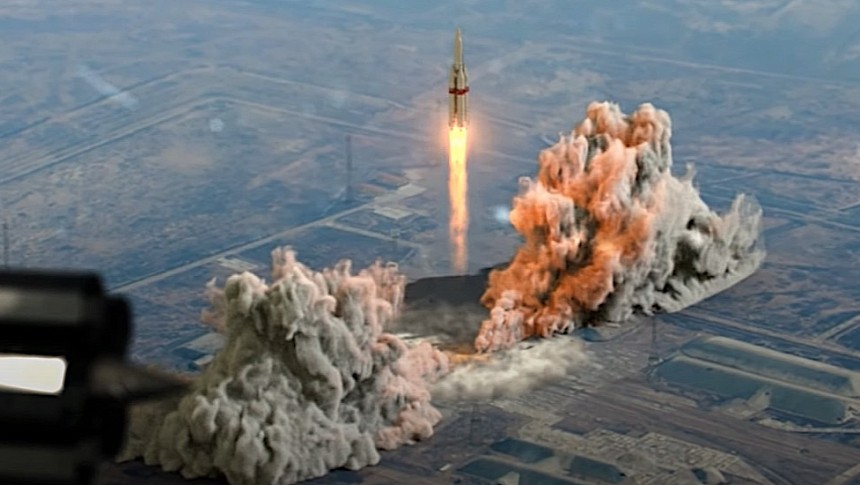The world of nuclear weapons is a very diverse one in terms of power and range. Like everything else we humans do, one of them does however sit at the top of the food chain: the Tsar Bomba.
By far the most powerful nuclear weapon ever detonated, the nuke would have been enough to devastate the Soviet Union's enemies. In a simulation run on Nukemap, for instance, detonating it right over New York's East Village would have resulted in a fireball with a radius of over three miles (five km), and its effects would have been felt as far as Cortlandt to the North, Mount Olive to the West, and Wall Township to the South.
The Tsar blew up only once, with the power of 50 megatons, in a test the Soviets conducted at the Mityushikha Bay test site on Severny Island. It generated a light so powerful that was visible from more than 620 miles (1,000 km) away, its mushroom cloud reached 42 miles (67 km) high, and the blast wave moved around the world three times.
Impressive as it may have been, the bomb posed some serious challenges when it came to delivering it. During the test the Russians used a specially modified Tupolev Tu-95 aircraft, but that wouldn't have cut it if the bomb was to be dropped on America's lap. So the Russians started looking at rockets as potential means of delivery.
Legend has it one of the proposed solutions was something called the R-56 rocket. The concept first came to light in the same decade the Russians tested the Tsar from one of the country's lead rocket scientists, and a major contributor to the ICBM program of the USSR, Mikhail Yangel.
Although it was born with the nuclear bomb in mind, the R-56 was also meant to advance the Russians' more peaceful goals in space. It would have been capable of shipping 40 tons of cargo into low-Earth orbit, but it would have also been enough to launch probes to the Moon and the other planets of the solar system. Why, it was even considered as a potential facilitator of a Soviet lunar landing.
Three configurations of the rocket were studied in the early 1960s. The first was one with a single booster so large (6.5 meters/21 feet in diameter) it would have needed to be transported over water. The second version relied on a four-configuration, and the third used no less than seven boosters. For propulsion, the rocket would have used the same engines as the ones on the Proton rocket.
The rocket never got past a stage where it would have deserved a name for itself - people tend to call the multi-booster versions polyblocks. The program was scrapped in the mid-1960s, when it became obvious the Russians were beginning to lose the space race.
There is one way we can see the R-56 in action, and that's thanks to a computer animation video. Specialist Hazegrayart is responsible for it, and you can enjoy it below. Don’t look for the Tsar exploding, though, as there’s no such thing in there.
The Tsar blew up only once, with the power of 50 megatons, in a test the Soviets conducted at the Mityushikha Bay test site on Severny Island. It generated a light so powerful that was visible from more than 620 miles (1,000 km) away, its mushroom cloud reached 42 miles (67 km) high, and the blast wave moved around the world three times.
Impressive as it may have been, the bomb posed some serious challenges when it came to delivering it. During the test the Russians used a specially modified Tupolev Tu-95 aircraft, but that wouldn't have cut it if the bomb was to be dropped on America's lap. So the Russians started looking at rockets as potential means of delivery.
Legend has it one of the proposed solutions was something called the R-56 rocket. The concept first came to light in the same decade the Russians tested the Tsar from one of the country's lead rocket scientists, and a major contributor to the ICBM program of the USSR, Mikhail Yangel.
Although it was born with the nuclear bomb in mind, the R-56 was also meant to advance the Russians' more peaceful goals in space. It would have been capable of shipping 40 tons of cargo into low-Earth orbit, but it would have also been enough to launch probes to the Moon and the other planets of the solar system. Why, it was even considered as a potential facilitator of a Soviet lunar landing.
Three configurations of the rocket were studied in the early 1960s. The first was one with a single booster so large (6.5 meters/21 feet in diameter) it would have needed to be transported over water. The second version relied on a four-configuration, and the third used no less than seven boosters. For propulsion, the rocket would have used the same engines as the ones on the Proton rocket.
The rocket never got past a stage where it would have deserved a name for itself - people tend to call the multi-booster versions polyblocks. The program was scrapped in the mid-1960s, when it became obvious the Russians were beginning to lose the space race.
There is one way we can see the R-56 in action, and that's thanks to a computer animation video. Specialist Hazegrayart is responsible for it, and you can enjoy it below. Don’t look for the Tsar exploding, though, as there’s no such thing in there.







